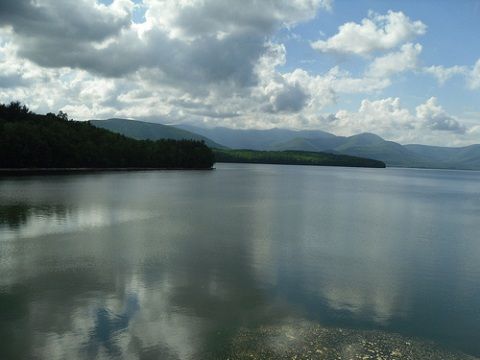
Still waters run deep. Photo of New York City's Ashokan Reservoir by Flickr user Doug Kerr. Published under Creative Commons license.
Ulster County's battle with NYC over the muddy Esopus has made the pages of the New York Times at last. Reporter Mireya Navarro tells it like it is:
For years, the resentment simmered as residents of Ulster County endured development bans, flooded basements and ruined crops, all for the sake of protecting New York City’s water supply.
But the last straw in a string of grievances was the browning of a cherished tributary that is vital to recreation and agriculture in this corner of the Catskills. Discontent has given way to full-throttle fury against the city, which has always called the shots on reservoir management in the region.
Kudos to Navarro for spending some 1,500 words on an issue that rarely crosses the radar screen of downstate media, even when it dominates local headlines and strains relations between NYC and upstate reservoir-dwellers to the breaking point.
Locals have long memories, so it's nice to see the New York Times does too. Navarro dug up some old dirt:
Then there is the long-held perception that the city will prevail in any dispute decided in Albany — and, worse, that people downstate belittle rural dwellers. People here still recall a 1984 Playboy magazine interview in which Edward I. Koch, then New York’s mayor, scoffed at country people in “gingham” dresses and “Sears Roebuck” suits.
But while Ulster County's drama with the city is getting increasing notice from downstate -- fueled largely by the feisty media stunts of their charismatic executive, Mike Hein -- other parts of the city's upstate watershed have deep issues with the city that aren't getting the same kind of press.
Though the Ashokan releases push all kinds of populist buttons upstate, there's no easy fix to Ulster County's muddy Esopus blues. Navarro notes that the state ordered the city Department of Environmental Protection to reduce their use of alum, a chemical used to settle turbidity out of drinking water, in 2007. With alum treatment increasingly off the table as an option, the city has resorted to releasing excess turbid water from the Ashokan and into the lower Esopus.
Another tactic is to try to reduce turbidity before it goes into the reservoir in the first place -- the goal of the city's locally controversial land acquisition program, under which the city buys vacant land around the reservoirs to prevent development.
Since the Irene and Lee floods last summer, the city has been engaging in talks with local officials about redirecting some land acquisition funds to flood prevention -- particularly in Delaware County, over half of which lies in the watershed.
Preventing major flooding in the watershed would reduce turbidity in the reservoirs, and in the wake of the devastation wreaked by Irene and Lee, it's a cause everybody can get behind. But one of the propositions on the table is raising hackles among local residents: Relocating entire sections of flood-prone communities.
The Coalition of Watershed Towns, a organization that lobbies and negotiates on behalf of upstate towns in the NYC watershed, recently held a meeting at Catskill Watershed Corporation headquarters in Margaretville to discuss the issue. The Catskill Mountain News reported from the meeting:
In some cases, [CWT lawyer Jeffrey] Baker added, those plans are expected to be ambitious, daunting and scary. But it is still important that such plans be made.
“In some cases entire sections of a town will be moved,” he said. “That is a big deal. No one is going to minimize that.”
Prior to last year's floods, "buyout" was a dirty word in the region, and talk of the city buying homes and businesses in the watershed still arouses local fears that New York City is actively working to depopulate the area. Expect this issue to heat up as the city's talks with local officials over flood prevention move forward.














